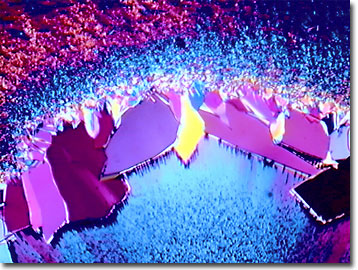Polarized Light Digital Image Gallery
Thiamine (Vitamin B-1)
Thiamine (more commonly referred to as vitamin B-1) was previously known as the anti-beriberi factor, and is essential for carbohydrate metabolism as a coenzyme. Aerobic metabolism and the conduction of nerve impulses also involves vitamin B-1. Thiamine is unstable to heat, alkali, oxygen, and radiation. As a B-complex vitamin, thiamine is soluble in water and in the body, supplies are rapidly depleted, and must be replaced regularly. An overdose of vitamin B-1 (thiamine shock) is indicated by weakness, a burning sensation, nausea, gastrointestinal hemorrhage, pulmonary edema, collapse, and even death.

View a second image of thiamine.
In 1911, British chemist Casimir Funk isolated the anti-beriberi factor (probably nicotinic acid) from rice bran extracts and coined the term "vitamine" for "vital amine". Fifteen years later in Java, two Dutch biochemists crystallized vitamin B-1 from rice bran and dubbed it aneurin for "antineuritic vitamin". However, there was an error in their formula (omitting a sulfur atom from the molecule), which confused the biochemical and medical worlds until 1936 when American physician Robert R. Williams published the correct formula and elucidated its biosynthesis as "thiamin."
In the body, the heart, kidney, liver, and brain have the highest concentrations of thiamine, followed by the leukocytes and red blood cells. Natural sources of thiamine are common and include meats, poultry, whole grain cereals, nuts, legumes, and brewer's yeast. White rice and white flour have their thiamine-rich content stripped away during processing. Cooking food removes about 25 percent of the thiamine and if possible, because of its water solubility, juices should be recovered and used. Dietary supplements in the form of extractions, synthetics, and enriched foods, such as breakfast cereals and breads, help meet the daily recommended allowance (RDA) of 0.5 milligrams per 1,000 kilocalories of food and drink intake. Based on average caloric intake, this translates into 1.2 to 1.5 milligrams per day for men and 1.0 to 1.1 milligrams per day for women. Chemical synthesis of thiamine was first developed in 1937, but because it takes from 15 to 17 steps, commercial production did not really take off until the 1950s when demand rose sharply because of food fortification and the growing popularity of multivitamin supplements.
Antagonists of vitamin B-1 include coffee, tea, raw fish, betel nuts, while vitamins B-12, B-6, niacin, and pantothenic acid are synergists. Heavy metal poisoning is typically characterized by symptoms common with thiamine deficiency since metals, such as arsenic or lead, block a crucial metabolic step converting thiamine to its coenzyme form. Diuretics and laxatives decrease thiamine availability. Beriberi, a vitamin B-1 deficiency disease prevalent in the Far East that translates into "I can't, I can't", was first described in the Seventh Century in Chinese medical writings. The disease is manifested through disorders of the cardiovascular and nervous systems. Switching from polished rice to fortified rice and cereal grains has helped eliminate this nutritional ailment. Alcoholics exhibit another B-1 deficiency syndrome (Wernicke-Korsakoff), because they often replace food intake with alcohol while decreasing the absorption of B-complex vitamins. This disease rears its ugly head with confusion, depression, psychosis (the DTs or delirium tremens), permanent memory impairment, and if untreated, coma. Interestingly, state liquor laws usually prohibit adding vitamins and other nutrients to alcohol products because of a historic separation of foods and spirits dating back to Prohibition.
Contributing Authors
Omar Alvarado, Thomas J. Fellers and Michael W. Davidson - National High Magnetic Field Laboratory, 1800 East Paul Dirac Dr., The Florida State University, Tallahassee, Florida, 32310.
BACK TO THE POLARIZED LIGHT IMAGE GALLERY
BACK TO THE DIGITAL IMAGE GALLERIES
Questions or comments? Send us an email.
© 1995-2025 by Michael W. Davidson and The Florida State University. All Rights Reserved. No images, graphics, software, scripts, or applets may be reproduced or used in any manner without permission from the copyright holders. Use of this website means you agree to all of the Legal Terms and Conditions set forth by the owners.
This website is maintained by our
Graphics & Web Programming Team
in collaboration with Optical Microscopy at the
National High Magnetic Field Laboratory.
Last Modification Friday, Nov 13, 2015 at 01:19 PM
Access Count Since September 17, 2002: 15650
Visit the website of our partner in introductory microscopy education:
|
|
